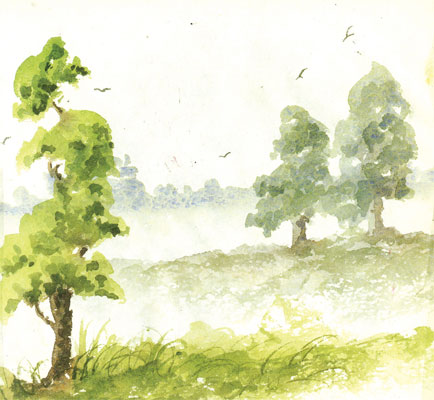Learn to draw by Tissa
HewavitaranePainting trees and foliage - Part 2
Trees tend to be the most prevalent objects in landscape paintings,
but they are also the most difficult to draw and paint. It is seldom
that we see a landscape painting without trees or bushes - even the
desert has scrub bushes and low gnarled trees. It is important for a
landscape painter to gain experience in drawing and painting trees.
Study the trees in the distance, see how they seem, either of one
value or a single flat colour. This is noticeable on a misty morning
when the distant landscape appears in flat layers, each close layer
being slightly darker than the previous one, and all are not different
from the colour of the sky.
|

A complete painting of trees with clusters of foliage |
Spend much time in studying the texture of the trunk (the area where
all the main branches leave the trunk), or the shape of the tree as a
whole. These studies will prove to be invaluable later when completing a
landscape painting. When it comes to painting trees and foliage, there
are two faults that occur time after time.
One is the lack of observation and the other is muddled brushwork.
When you are faced with a complex mass of foliage the beginner tries too
hard to render every leaf and twig to make the tree look 'real'. Such a
task is of course overwhelming and fatigue inevitably sets in.
The student stops looking at his subject and instead on perceived
notions of what a tree is supposed to look like, begins to paint.
At this point, colours begin to turn muddy, brushwork becomes sloppy
and the result is a stereotyped mass of 'lollipop' trees.
There is no sense of light and shade and no movement in the foliage.
The trees and shrubs appear solid and dense - there is not a single "skyhole"
in the foliage and the whole scenery appears unnatural. A good
watercolour painting of trees is one that looks fresh and spontaneous.
The way to achieve this quality is to translate all these complex
shapes and textures into a simple language. In other words, use
descriptive brushwork to suggest details.
Make a habit of studying the characteristic shapes of various trees
taking note of their proportions and growth habits. Instead of trying to
paint individual leaves, let your brushstrokes suggest them. In the
trees shown here, I have used small flecks and dabs of paint which
indicate clusters of foliage without appearing stilted.
Observe the direction of light and paint on the side of the tree
facing it with lighter, warmer greens than the shaded side. One
important factor that is often overlooked is the gaps between branches.
Even when a tree is full of leaves, keep lots of small gaps through
which the sky is visible.
Tiny gaps of white paper create a shimmering effect that gives the
whole scene freshness and sparkle. |

